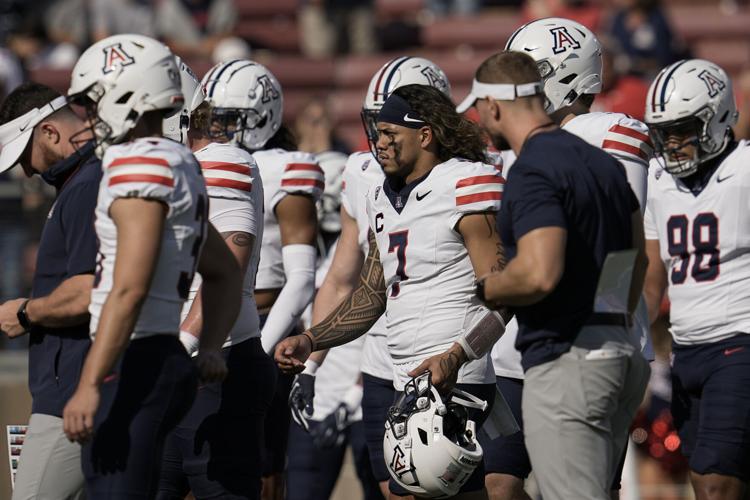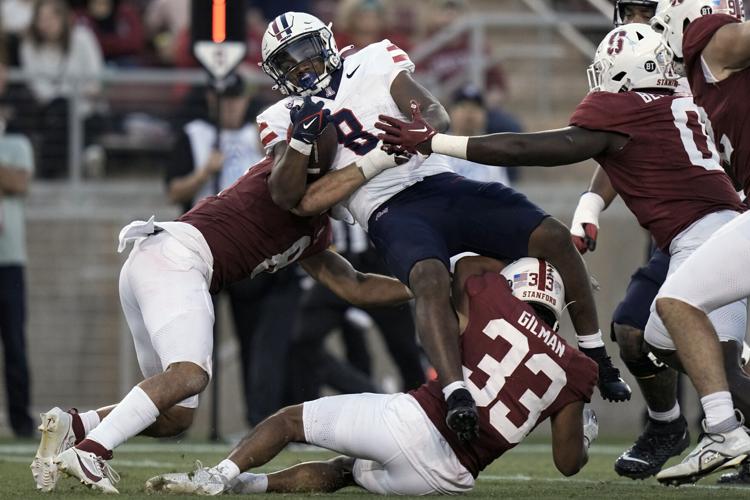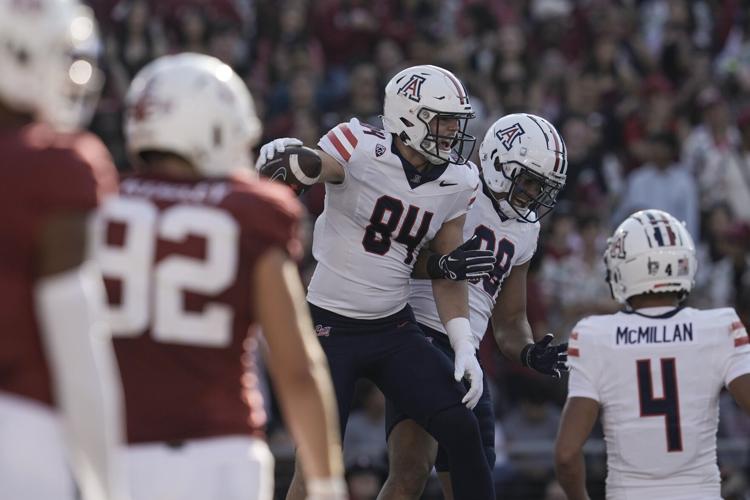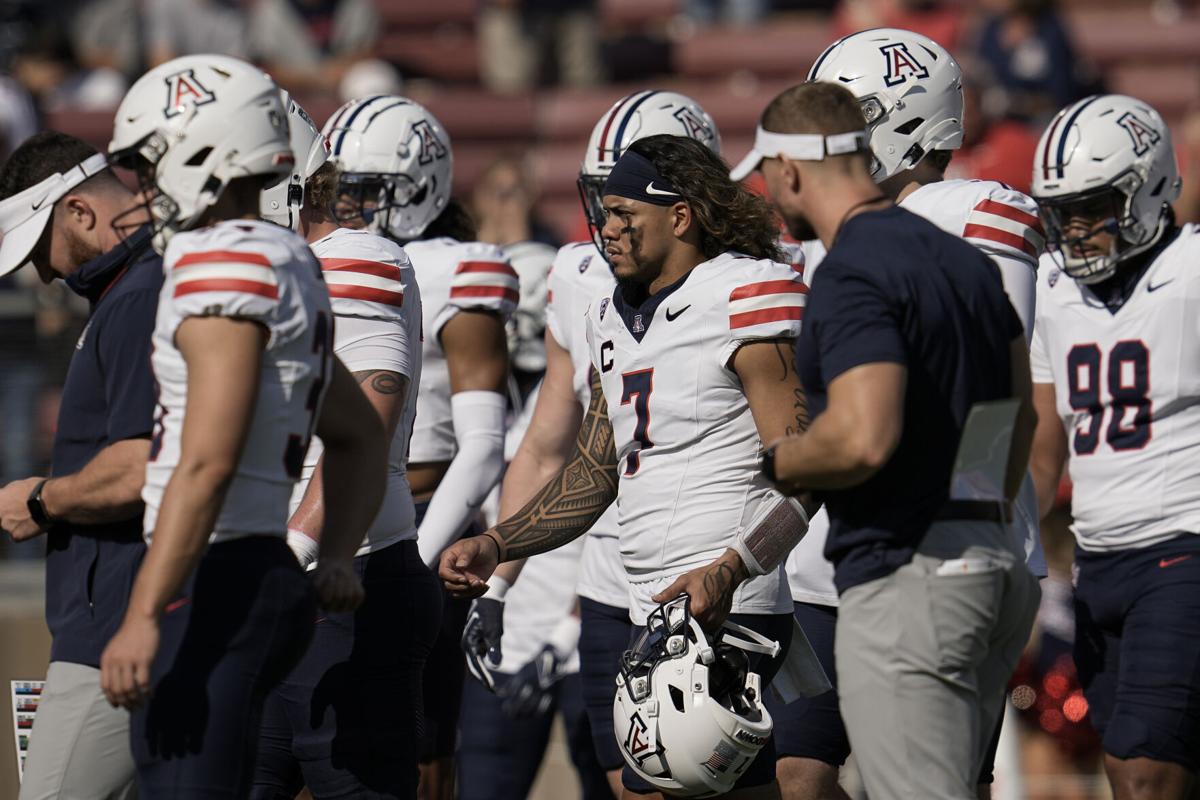Arizona barely escaped Stanford with a victory in a game it was favored to win by two scores.
Along the way, several Wildcats went down with injuries — including starting quarterback Jayden de Laura, whose backup, Noah Fifita, helped save the day.
So yeah, lots to talk about in the wake of the Cats’ 21-20 victory over the Cardinal on Saturday. Here are my top five takeaways on the game:
1. QB conundrum
Do we have a quarterback controversy in Tucson? Is it time to make a change, regardless of de Laura’s status?
I feel pretty confident in saying that Jedd Fisch will not make a QB swap if de Laura’s apparent right ankle injury is minor and he’s cleared to play against No. 7-ranked Washington this week. But it shouldn’t be a slam-dunk decision. Based on what we saw Saturday — heck, what we’ve since late last year — changing quarterbacks ought to merit serious consideration.
Fisch made the point after the game that Arizona has won five of its past seven games. De Laura has played well — really well — in only three of them: UCLA, NAU and UTEP.
He didn’t turn the ball over a single time against Stanford, a positive development to be sure. But he didn’t move the offense with any consistency (more on that in item No. 2). Meanwhile, Fifita got the ball out of his hand quickly, executed under pressure and handled a tense situation with complete calm.
Did Fisch call simpler plays for Fifita? Was Stanford playing an easier-to-decipher defense? Was Fifita seeing things that de Laura wasn’t?
I will readily acknowledge that it’s a small sample size. Fifita played only two possessions. No one has any meaningful film on him. In a sense, it’s like facing a pitcher for the first time and not knowing what he throws. Adjustments will be made as the book on Fifita adds more chapters.
It’s also the easiest thing in the world to blame all of the offense’s problems on the quarterback and to assume the backup will fix everything.
But of this I’m certain: The offense looked different when Fifita was operating it.
He deserves a chance to run it for an entire game.

Michael Lev is a senior writer/columnist for the Arizona Daily Star, Tucson.com and The Wildcaster.
2. Offensive issues
Arizona’s offense had a strange statistical profile entering Saturday. The Wildcats were compiling yards at a high rate. But they weren’t scoring points at a commensurate pace.
The NAU game was weird in terms of possessions and the total number of plays. The Mississippi State game was a turnover fest. The UTEP game had an issue here and an issue there.
This was not that.
Arizona flat-out struggled to move the ball in the first half against Stanford. Aside from one series, the Wildcats had no rhythm.
It’s difficult to tell what’s happening down the field when watching on TV. Here’s what you could see, all too often: de Laura dropping to pass, not finding anyone open, holding the ball, running around and throwing it away. On the play where he got hurt, that was the exact sequence of events.
What’s maddening about de Laura is that you truly never know what you’re going to get from one Saturday to the next. His game log mirrors his play style: Both are all over the place.
One week after completing an Arizona-best 79.3% of his passes, de Laura hit on just 53.8% (14 of 26). This didn’t happen against Utah. It happened against the worst pass defense in the Pac-12 entering Saturday.
I never thought I’d say this entering this season, but it’s inescapable at this point: While the defense is balling out, the offense is holding Arizona back. About that defense ...
3. A defensive oddity
What a gutty, strange performance by Johnny Nansen’s group. The Wildcats limited the Cardinal to 20 points; even if the normally reliable Joshua Karty had made the two 51-yard field goal attempts that he missed, Stanford would have had only 26 points. More often than not in modern college football, that’s good enough to win.
Arizona had 11 tackles for loss, including five sacks — the Wildcats’ most in a game since 2018. They did it without Bill Norton, who’s arguably been their most important defender, and, for most of the game, Justin Flowe, who’d been coming on like a freight train.
Arizona put Stanford in compromising situations time and again. The Cardinal faced 16 third downs, and the average distance required to convert them was 11 yards. That’s exactly what defenses are supposed to do. And yet ...
Stanford converted third downs from the following distances: 7, 15, 11, 12, 12 and 9 yards. One of those was a questionable pass-interference call against Tacario Davis, but still: How could the UA defense do so many things right except the one thing that, in theory, should be the “easiest” to execute?
That oddity aside, you couldn’t help but impressed by the overall defensive effort — particularly the front. Even shorthanded, the Wildcats never stopped coming.

Arizona running back DJ Williams (8) gained the hard yards against Stanford and helped the Wildcats put away the Cardinal in the fourth quarter.
4. Not out of their depth
Arizona’s depth was put to the test at Stanford. Five regulars went down or were extremely limited. It’s a testament to the recruiting and team building done by Fisch and his staff that the Wildcats were able to endure it.
Arizona’s depth really stood out at running back, where Michael Wiley got dinged in the first quarter and didn’t play from the second period on.
Jonah Coleman rushed for 75 yards on 12 carries — the third time in his career he’s had 10-plus totes. Coleman also had three catches for 22 yards. (The initial box score gave him four for 29, but it erroneously awarded the final reception to Coleman instead of Jacob Cowing.) There’s no doubt in my mind — zip, zero, zilch — that Coleman could carry the load if called upon.
Meanwhile, DJ Williams scored the winning touchdown and converted the clinching first down. In the course of pulling off the latter, Williams made one of the smartest plays of the night — sliding down to stay inbounds to make sure the only clock stoppage was to move the chains.
On the preceding play, Rayshon Luke gained 6 yards. What’s notable about that? Well, the coaching staff trusted him in a situation where ball security was paramount. That was the supposed reason Luke hadn’t been allowed to return kickoffs. I’d love to see him in that role, whether Wiley’s available or not.

Arizona tight end Tanner McLachlan (84) celebrates with Keyan Burnett (88) after scoring a touchdown against Stanford during the first half in the 2023 game.
5. Only harder from here
One-time Stanford Cardinal Tiger Woods once said he won a tournament without his “A-game.”
Arizona defeated Stanford without its A-game, and that’s an important step for the program. If the Wildcats are in the “win close” stage of their build under Fisch, well, that’s precisely what they just did. It’s something they likely wouldn’t have been able to do under the same set of circumstances a year ago. This was a character-building victory.
What’s concerning is that Stanford was really struggling entering Saturday — and UW is demolishing everything in its path.
The Cardinal got obliterated by a USC team that never ran away from a depleted Arizona State squad Saturday night. Stanford then lost at home to Sacramento State.
The Huskies have yet to score fewer than 41 points in a game. Michael Penix Jr. will be, by far, the best quarterback Arizona has faced this season. The Wildcats will be heavy underdogs.
They’re going to have to execute a lot better to have any chance against the Huskies. The heart, effort and will to win are abundant, though. That’s a start.
VIDEO: Following Arizona's 21-20 win at Stanford on Sept. 23, 2023, UA coach Jedd Fisch said of the Wildcats' 11 tackles for loss and five sacks: “If you always swarm the ball … that’s how you’re able to get tackles for loss." Video by Justin Spears/Arizona Daily Star
VIDEO: After Arizona's 21-20 win Sept. 23, 2023, UA football coach Jedd Fisch spoke on the Wildcats' “hard-fought battle” at Stanford, gave Jayden de Laura/Michael Wiley injuries and discussed Noah Fifita’s “tough situation.” Video by Justin Spears/Arizona Daily Star
VIDEO: After Arizona's 21-20 win at Stanford Sept. 23, 2023, UA coach Jedd Fisch says the control quarterback Noah Fifita showed “was the most important and impressive thing” once starter Jayden de Laura left with a leg injury. “Thought Noah handled himself beautifully in that situation and there was no flinch.” Video by Justin Spears/Arizona Daily Star
VIDEO: “One thing about him, he’s always going to be prepared," said Arizona linebacker Jacob Manu on longtime teammate (both in high school and college) Noah Fifita, who came in at quarterback Sept. 23, 2023 to help lead the Wildcats to a 21-20 win at Stanford. Video by Justin Spears/Arizona Daily Star
VIDEO: “There was a little too many for my liking today," Arizona football coach Jedd Fisch of Arizona’s several injuries during the Wildcats' 21-20 win Sept. 23, 2023, at Stanford. While Jayden de Laura left the game with a leg injury, and OL Raymond Pulido also had setbacks, Fisch added that DT Bill Norton was held out on defense due to a shoulder injury. Video by Justin Spears/Arizona Daily Star
VIDEO: Arizona quarterback Noah Fifita chatted with Pac-12 Network after coming off the bench to help lead the Wildcats to a 21-20 win at Stanford on Sept. 23, 2023.
For everything Pac-12 ➡️ http://pac-12.com
Download the Pac-12 Now app ➡️ http://pac12.me/app
Follow the Pac-12 on Instagram ➡️ http://pac12.me/instagram
Like the Pac-12 on Facebook ➡️ http://pac12.me/facebook
Follow the Pac-12 on Twitter ➡️ http://pac12.me/twitter
Follow Pac-12 Network on Twitter ➡️ http://pac12.me/NetworkTwitter
Follow the Pac-12 on TikTok ➡️ http://pac12.me/TikTok
Photos: Arizona football opens Pac-12 slate with road win at Stanford

Stanford running back Sedrick Irvin, right, runs the ball against Arizona safety Isaiah Taylor (4) during the first half of an NCAA college football game Saturday, Sept. 23, 2023, in Stanford, Calif. (AP Photo/Godofredo A. Vásquez)

Stanford place-kicker Joshua Karty kicks a field goal against Arizona during the first half of an NCAA college football game Saturday, Sept. 23, 2023, in Stanford, Calif. (AP Photo/Godofredo A. Vásquez)

Stanford quarterback Justin Lamson throws a pass against Arizona during the first half of an NCAA college football game Saturday, Sept. 23, 2023, in Stanford, Calif. (AP Photo/Godofredo A. Vásquez)

Arizona running back Jonah Coleman (3) carries against Stanford during the first half of an NCAA college football game Saturday, Sept. 23, 2023, in Stanford, Calif. (AP Photo/Godofredo A. Vásquez)

Stanford quarterback Ashton Daniels, right, looks for a receiver during the first half of the team's NCAA college football game against Arizona on Saturday, Sept. 23, 2023, in Stanford, Calif. (AP Photo/Godofredo A. Vásquez)

Arizona running back DJ Williams carries against Stanford during the first half of an NCAA college football game Saturday, Sept. 23, 2023, in Stanford, Calif. (AP Photo/Godofredo A. Vásquez)

Arizona tight end Tanner McLachlan, right, gets past Stanford safety Scotty Edwards, left, on his way to a touchdown during the first half.

Arizona tight end Tanner McLachlan (84) celebrates with Keyan Burnett (88) after scoring a touchdown against Stanford during the first half in the 2023 game.

Arizona head coach Jedd Fisch watches warmup before the team's NCAA college football game against Stanford on Saturday, Sept. 23, 2023, in Stanford, Calif. (AP Photo/Godofredo A. Vásquez)

Stanford running back Sedrick Irvin carries against Arizona during the first half of an NCAA college football game Saturday, Sept. 23, 2023, in Stanford, Calif. (AP Photo/Godofredo A. Vásquez)

Arizona quarterback Jayden de Laura (7) throws a pass against Stanford during the first half of the Wildcats' Sept. 23 win over the Cardinal in Stanford, California. Heading into Arizona's matchup with Washington State, de Laura hasn't played since that win at Stanford. To date, it's also the last time Arizona was victorious this season.

Stanford wide receiver Tiger Bachmeier, right, is unable to catch a pass in the end zone while defended by Arizona cornerback Ephesians Prysock during the first half of an NCAA college football game Saturday, Sept. 23, 2023, in Stanford, Calif. (AP Photo/Godofredo A. Vásquez)

Stanford quarterback Justin Lamson, right, runs the ball against Arizona during the first half of an NCAA college football game Saturday, Sept. 23, 2023, in Stanford, Calif. (AP Photo/Godofredo A. Vásquez)

Stanford running back Sedrick Irvin carries against Arizona during the first half of an NCAA college football game Saturday, Sept. 23, 2023, in Stanford, Calif. (AP Photo/Godofredo A. Vásquez)

Stanford players take the field for an NCAA college football game against Arizona on Saturday, Sept. 23, 2023, in Stanford, Calif. (AP Photo/Godofredo A. Vásquez)

Arizona quarterback Jayden de Laura (7) participates in warmups before the Wildcats' game at Stanford on Sept. 23, 2023. De Laura would get injured in the third quarter, and the game against the Cardinal would mark his final start as a Wildcat.

Arizona tight end Tanner McLachlan (84) runs with the ball after a catch during the first half of the team's NCAA college football game against Stanford on Saturday, Sept. 23, 2023, in Stanford, Calif. (AP Photo/Godofredo A. Vásquez)

Stanford safety Alaka'i Gilman, front, tackles Arizona running back DJ Williams during the first half of an NCAA college football game Saturday, Sept. 23, 2023, in Stanford, Calif. (AP Photo/Godofredo A. Vásquez)

Stanford quarterback Ashton Daniels (14) throws a pass against Arizona during the first half of an NCAA college football game Saturday, Sept. 23, 2023, in Stanford, Calif. (AP Photo/Godofredo A. Vásquez)

Stanford coach Troy Taylor watches from the sideline during the first half of the team's NCAA college football game against Arizona on Saturday, Sept. 23, 2023, in Stanford, Calif. (AP Photo/Godofredo A. Vásquez)

Stanford quarterback Justin Lamson looks for a receiver during the first half of the team's NCAA college football game against Arizona on Saturday, Sept. 23, 2023, in Stanford, Calif. (AP Photo/Godofredo A. Vásquez)

Arizona tight end Tanner McLachlan (84) hurdles Stanford safety Alaka'i Gilman during the second half of the Wildcats 21-20 road win last Saturday.

Arizona tight end Tanner McLachlan (84) hurdles Stanford safety Alaka'i Gilman (33) during the second half of an NCAA college football game Saturday, Sept. 23, 2023, in Stanford, Calif. (AP Photo/Godofredo A. Vásquez)

Arizona running back DJ Williams, center top, is tackled by Stanford linebacker Tristan Sinclair, left, and safety Alaka'i Gilman (33) during the second half of an NCAA college football game Saturday, Sept. 23, 2023, in Stanford, Calif. (AP Photo/Godofredo A. Vásquez)

Stanford running back Sedrick Irvin celebrates after scoring a touchdown against Arizona during the second half of an NCAA college football game Saturday, Sept. 23, 2023, in Stanford, Calif. (AP Photo/Godofredo A. Vásquez)

Stanford running back Sedrick Irvin (26) runs for a touchdown against Arizona during the second half of an NCAA college football game Saturday, Sept. 23, 2023, in Stanford, Calif. (AP Photo/Godofredo A. Vásquez)

Arizona quarterback Jayden de Laura, right, celebrates with wide receiver Tetairoa McMillan (4) after scoring a rushing touchdown against Stanford during the second half of an NCAA college football game Saturday, Sept. 23, 2023, in Stanford, Calif. (AP Photo/Godofredo A. Vásquez)

Stanford wide receiver Tiger Bachmeier, right, catches a pass while defended by Arizona safety Gunner Maldonado during the second half of an NCAA college football game Saturday, Sept. 23, 2023, in Stanford, Calif. (AP Photo/Godofredo A. Vásquez)

Stanford wide receiver Tiger Bachmeier, right, catches a pass while defended by Arizona safety Gunner Maldonado during the second half of an NCAA college football game Saturday, Sept. 23, 2023, in Stanford, Calif. (AP Photo/Godofredo A. Vásquez)

Stanford wide receiver Tiger Bachmeier, right, catches a pass while defended by Arizona safety Gunner Maldonado during the second half of an NCAA college football game Saturday, Sept. 23, 2023, in Stanford, Calif. (AP Photo/Godofredo A. Vásquez)

Arizona quarterback Jayden de Laura scores a rushing touchdown against Stanford during the second half of an NCAA college football game Saturday, Sept. 23, 2023, in Stanford, Calif. (AP Photo/Godofredo A. Vásquez)

Stanford tight end Benjamin Yurosek, center, is unable to catch a pass in the end zone during the second half of the team's NCAA college football game against Arizona on Saturday, Sept. 23, 2023, in Stanford, Calif. (AP Photo/Godofredo A. Vásquez)








